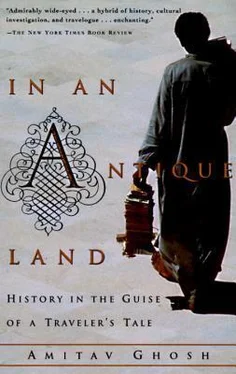It was a small enclave within this formation that eventually became home to Abraham Ben Yiju, the master of the Slave of MS H.6: a Roman fortress called Babylon. The fort was built by the emperor Trajan in 130AD, on the site of an even earlier structure, and the Romans are said to have called it Babylon of Egypt, to distinguish it from the Mesopotamian Babylon. The name may have come from the Arabic Bâb il-On, ‘The Gate of On’, after the ancient sanctuary of the Sun God at Heliopolis, but there are many contending theories and no one knows for sure. The fort has had other names, most notably Qa  r al-Shama‘, Fortress of the Lamp, but it is Babylon that has served it longest.
r al-Shama‘, Fortress of the Lamp, but it is Babylon that has served it longest.
The entrance to Babylon was once guarded by two massive, heavily buttressed towers: one of them is now a ruined stump, and the other was incorporated several centuries ago into the structure of a Greek Orthodox church. Today the towers, and the gateway that lies between them, are separated from the Nile by several hundred metres. But at the time when the fortress was built the river flowed directly beside it: the reason why the towers were so solidly constructed is that they served as Babylon’s principal embankment against the annual Nile flood. In the early years of Babylon’s history, the towers were flanked by a port. As the centuries advanced and the conurbation around the fortress grew in size and importance, the river retreated westwards and the docks and warehouses gradually expanded along the newly emerged lands on the bank. In Ben Yiju’s time the port was one of the busiest in the Middle East; it was said to handle more traffic than Baghdad and Basra combined.
Today there is a steel gate between Babylon’s twin towers, and millions of visitors pour through it every year. But the fort’s second great gateway, in its southern wall, is no longer in use: its floor is deep in water now, swamped by Cairo’s rapidly rising water-table. A thick film of green slime shimmers within its soaring, vaulted interior, encircling old tyres and discarded plastic bottles. Incredible as it may seem, this putrefying pit marks the site of what was perhaps the single most important event in the history of Cairo, indeed of Egypt: it was through this gateway that the Arab general ‘Amr ibn al-‘Â  is thought to have effected his entry into Babylon in 641AD — the decisive event in the futû
is thought to have effected his entry into Babylon in 641AD — the decisive event in the futû  , the Muslim victory over the Christian powers in Masr.
, the Muslim victory over the Christian powers in Masr.
For Babylon, ironically, the moment of capitulation marked its greatest triumph for it was then that this tiny fortress fixed the location of the country’s centre of gravity, once and for all. It was Alexandria that was Egypt’s most important city at the time of the Arab invasion; founded by Alexander the Great in 332BC it had served as the country’s capital for almost a thousand years. Babylon, on the other hand, was a mere provincial garrison, a small military outpost. By rights therefore, it was Alexandria’s prerogative to serve as the funnel for the assimilation of the newcomers.
But the conquering Muslim general, ‘Amr ibn al-‘As, broke with the usual practice of invaders by electing to base his army not in the country’s capital, but in an entirely new city. The location he chose was the obvious one — the site the Arab army had used for its camp while laying siege to Babylon. The fortress was thus the promontory that served to anchor the Cairo archipelago: ever afterwards Egypt’s capital, Masr, Egypt’s metaphor for itself, has lain within a few miles of Babylon.
The legend goes that on the morning when ‘Amr was to lead his army against Alexandria he woke to find a dove nesting on top of his tent. Loath to invite misfortune by disturbing the bird, he left the tent behind and upon returning to Babylon after his successful assault on Alexandria, laid out his new city around the nest-topped tent. The legend is universally believed in Cairo, and everyone who repeats it adds that the name of ‘Amr’s city, al-Fus  â
â  , was derived from the Arabic for tent. But in fact the story came into circulation long after the event and is almost certainly apocryphal. It is possible that the name does not come from an Arabic source at all, being related instead to the Latin-Greek word ‘fossaton’, which is also the parent of an archaic and unglamorous English word, ‘fosse’, or ditch.
, was derived from the Arabic for tent. But in fact the story came into circulation long after the event and is almost certainly apocryphal. It is possible that the name does not come from an Arabic source at all, being related instead to the Latin-Greek word ‘fossaton’, which is also the parent of an archaic and unglamorous English word, ‘fosse’, or ditch.
Fustat served as Egypt’s capital for more than three centuries, but then a new invasion and a new set of conquerors moved the centre of power a couple of miles northwards. The new rulers were the Fatimids, a dynasty which had its beginnings in North Africa, in an esoteric Shî‘a sect whose members were known as Ismâ‘îlîs. In 969AD one of their generals, a former Greek slave called Jawhar al-Rûmî, marched against Egypt with a hundred thousand men. Their army routed the Egyptians in a battle near Fustat and the inhabitants of the city soon sued for peace. Like ‘Amr ibn al-‘As before him, Jawhar the Greek marked out the boundaries of a new township right beside the conquered city. Soothsayers are said to have named the town al-Qâhira, the Martial, or the Victorious, because the planet Mars, al-Qâhir, was in the ascendant at the time of the foundation ceremony. It was this name that was to pass into European languages as Cairo, Le Caire and the like.
In its original conception al-Qahira was a planned capital, an early forebear of New Delhi, Canberra, Brasilia and other such haunts of officialdom. The Caliph had his residence there and it contained many notable buildings, but everything in it was the personal property of the rulers and its shops and bazaars existed only to serve him and his entourage. In time the character of al-Qahira was to change entirely and it was to become a frantic, crowded district, the bustling nucleus of the conurbation of Cairo. But all that came later: in the early years of the twelfth century when Ben Yiju first came to Masr it was probably still a relatively solemn, bureaucratic kind of place. At the time, the Fatimids, who had long since embarked on a course of catastrophic decline, were clinging to the last tatters of their power, and their capital was still largely a ceremonial and administrative township. It was Fustat then that probably had something of the busy, market-place character of al-Qahira today.
Thriving hub though it was, medieval Fustat probably presented an unremarkable kind of appearance. Archæological excavations have shown that its dwellings were, for the most part, made of the material that is still most in evidence in rural Egypt today, dried mud and straw — a substance that sounds somehow more glamorous when spoken of by the term ‘adobe’, a term appropriately applied here, since the word probably derives from the Arabic al-  ûb, ‘the brick’. Possibly Fustat even had something of the distinctive look of an Egyptian village: that tousled, mop-haired appearance that is characteristic of fellah houses, with great ricks of straw and firewood piled high on their roofs.
ûb, ‘the brick’. Possibly Fustat even had something of the distinctive look of an Egyptian village: that tousled, mop-haired appearance that is characteristic of fellah houses, with great ricks of straw and firewood piled high on their roofs.
But in fact there was nothing remotely rustic about medieval Fustat, whatever its appearance. With the political ascendancy of the Fatimid Empire, it had come to play a pivotal role in the global economy as the entrepôt that linked the Mediterranean and the Indian Ocean: the merchandise that flowed through its bazaars came from as far afield as East Africa, southern Europe, the western Sahara, India, China and Indonesia. By Ben Yiju’s time Fustat had long since become the largest island in the emerging archipelago of Masr: the juncture of some of the most important trade routes in the known world and the nucleus of one of the richest and most cosmopolitan cities on earth.
Читать дальше

 r al-Shama‘, Fortress of the Lamp, but it is Babylon that has served it longest.
r al-Shama‘, Fortress of the Lamp, but it is Babylon that has served it longest. , the Muslim victory over the Christian powers in Masr.
, the Muslim victory over the Christian powers in Masr. â
â 










